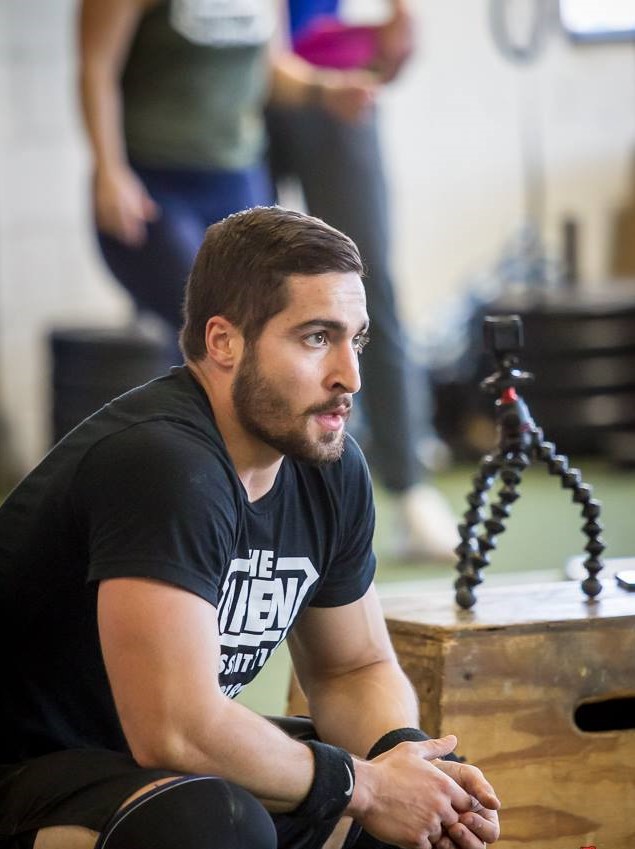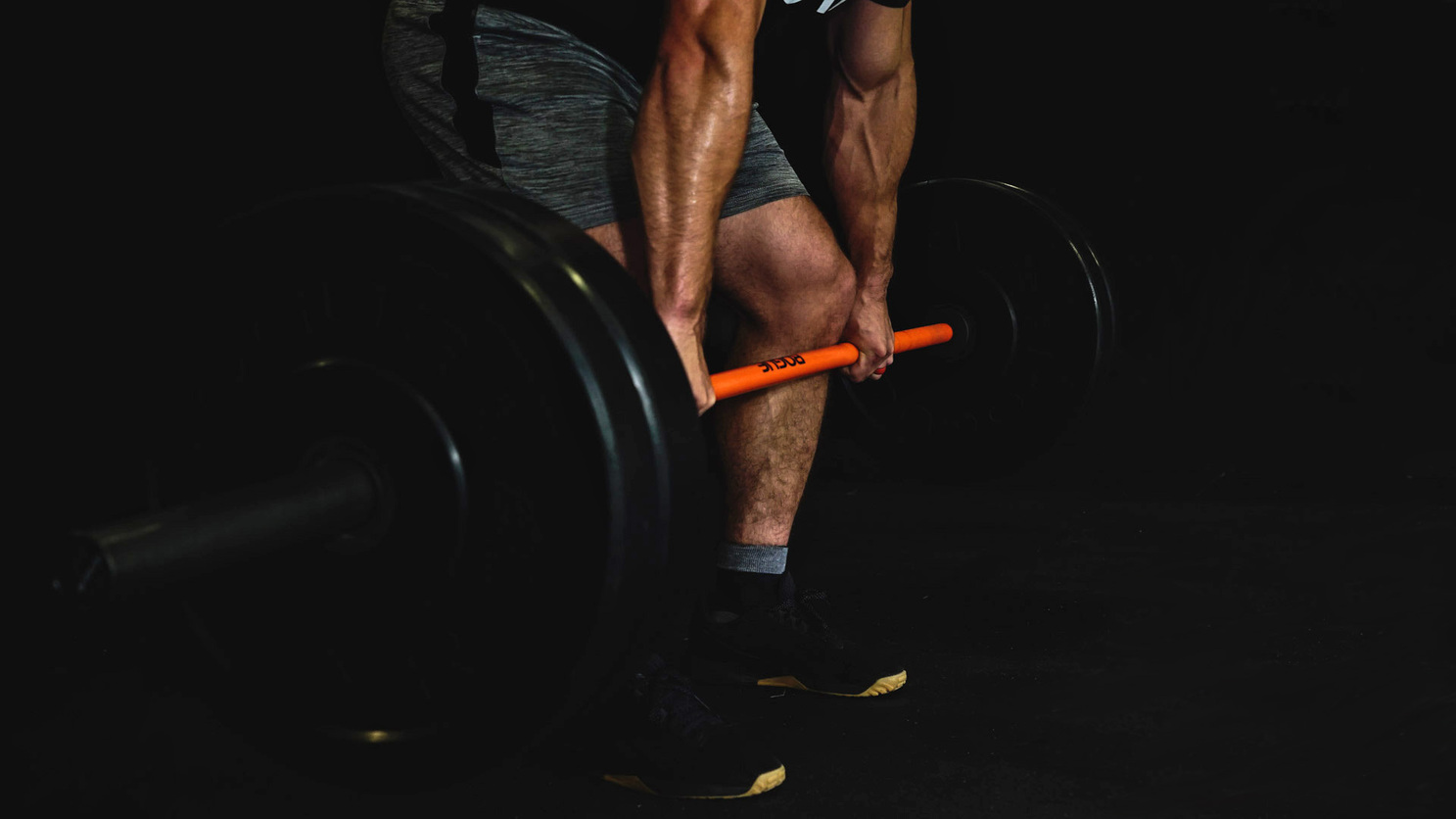The Workout
CrossFit® Open Workout 22.1
AMRAP 15:00
-3 Wall Walk
-12 DB Snatch 50/35lb
-15 Box Jump Over* 24/20″
*must step down
ZOAR Competition Guide
What does it cover?
- Movement standards
- Rep Breakdowns
- Splits Predictions
- Score / Time Predictions
- Nutrition & Visualization
- Gear & Equipment
- Filming & Judging
- Warm-Up & Cool-Down Protocol
- Post-Workout Notes & Analysis
- How to Improve a ReTest
- And More…

Movement Standards
Don’t overlook the workout’s movements standards.
Even if you have been doing this fitness thing for a long time, sometimes tweaks in the rules can make your attempt invalid, which can be devastating to your place on the leaderboard…and your season.
Plus, it’s really important not to waste an attempt and be forced to redo a workout due to a missed standard, which happened to many athletes in 21.1 with the Wall Walk Standard.
22.1 Scorecard, Standards & Line Setup
Noteworthy Standard #1: Wall Walk
Males use two lines: 60 inches & 10 inches
Females use two lines: 55 inches & 10 inches
You must touch the wall with both feet (not just off the floor) before you can move your hands off the line.
Noteworthy Standard #2: Box Jump Over
You must step down the box jump over.
Noteworthy Standard #3: Floor Plan
You start the workout facing the wall, standing behind your 60/55 inch line.
Your box must be at least 9ft from the wall you use for your wall walk.
Filming & Judging
You need to take time prior to when you walk into the gym to figure out the logistics of filming and judging.
First, reach out to someone at your gym or a friend and ask them to judge you, and to meet you at a specific time. Don’t just show up at the gym and hope someone is there. Pick a friend who is reliable, knows the standards and will project their voice so you can hear them.
Second, make sure you have the scorecard printed to give to your judge when you meet them. Also, be sure to let them know how your preferences… • Do you want every rep counted out loud?
• Maybe every fifth or tenth rep?
• Maybe each time you break?
• Maybe only certain movements?
Third, talk with your judge and give them permission to hold you to the standards. “Don’t be afraid to no rep me. Better you than HQ.” This may seem obvious, but if this person is your friend, they are often a little shy at first on the no reps.
Fourth, prior to starting your warm-up, setup your equipment and a clock where you plan on using it. Set up your camera making sure all stations are in frame with some extra space on the sides.
Put it on airplane mode; don’t let a spam phone call ruin your attempt. Make a mental note of where the edges are the frame are and make sure to avoid walking past that during transitions and rest during the workout.
Also, film your rehearsal. Then during your rest prior to starting your test, review it to double check all movements are in frame and that you can clearly see movement standards are being met.
Lastly, before submitting a video watch it through to make sure reps were counted correctly, and that the video is quality enough to be judged online.
Even if you don’t plan on qualifying for the next stage in the competition, videos serve as an important resource as to How to Improve on a ReTest.
Equipment Setup
See the floor plan on in the 22.1 PDF (see above).
Keep your implements as close as possible while obeying for floor plan.
Start and end your box jump overs on the side of the box closest to your dumbbell and the wall.
Live Announcement Lessons
The first thing to keep in mind is that you (probably) aren’t an elite athlete. The high pace that these athletes were able to hold is completely unrealistic for the everyday CrossFit athlete. Chances are your cycle speed and muscular endurance aren’t at that level.
So while there are things we can learn from these athletes attempting this workout, keep in mind that the carryover to you specifically might not be that much.
Be realistic with your current level of fitness, and base your pace on that. If you aren’t super conformable with one of the movements, be a touch conservative in the first part of the workout and plan to build your pace if you are able to do so.
That being said, all the athletes experienced a degrading pace (time per round) from beginning to end of the workout.
Vellner
Fastest: 1:09
Slowest: 1:25
Olsen
Fastest: 1:04
Slowest: 1:48
Brandon
Fastest: 1:13
Slowest: 1:26
Shadburne
Fastest: 1:12
Slowest 1:33
An interest note is that both athletes that won (Vellner & Brandon) had the most consistent round times. The athletes who dropped off the most (started fast and dropped off their pace) ended up losing the workout. Both losing athletes had the fastest and slowest split times.
Here are some split times based on the number of rounds you believe is realistic for your current level of fitness…
5 Rounds | 3:00
6 Rounds | 2:30
7 Rounds | 2:08
8 Rounds | 1:52
9 Rounds | 1:40
10 Rounds | 1:30
11 Rounds | 1:22
Pacing & Strategy
(Tip #1: Wall Walk Steps & Standard
The first thing to keep in your mind is the Wall Walk standard. It is easy to cheat the standard, especially by moving your hand off the line before your second foot touches the wall.
Don’t allow your score to be invalid due to not following the standard.
In terms of performance in this movement, the most important thing is minimizing your time under tension. The best way to do this is by using the least amount of “step” up and down the wall.
For many advanced athletes, this means 4 steps up the wall and 3 steps down.
Pick a number you think is sustainable and hold yourself to it.
Tip #2: Methodical Box Jump Over Technique
I’ve written on Box Jump Over Technique before, but this movement is a bit unique as it requires a step down…something many elite level athletes would not opt to do if they were given the choice.
That being said, I took the time to mimic what I believe a very efficient technique for Box Jump Overs. This is very close to what Vellner did in the live annoucement.
Here are what I see as the keys points of performance…
A. Jump at an Angle: To land with your one foot on the far side of the box, you need to land sideways. Being slightly turned prior to jumping prevents you from having to do a full 90 degree turn, which would be the case if you started facing the box.
B. Land with a Hovering Forefoot: It is really easy to get your outside foot caught on the box and waste precious time and energy as a result. The easiest way to prevent this from happening is landing on the box with the toe of your outside foot off the edge of the box, allowing you to shift your way to the forefoot and slide off with ease.
C. Touch …and Go: As soon as your inside foot comes off the box and impacts the floor it should be the start of your next jump. The impact of that foot to the floor create a stretch shortening cycle (SSC), and takes advantage of some of the positive aspects of a rebounding box jump.
Tip #3: Start Slow & Build If Able
The drop off in round pace from the elites should be a clear warning to the average competitive CrossFit athlete to start slower than you want.
In a 15 minute workout there is plenty of opportunity to build your pace in the second half of the workout if you feel you have the capacity, but there’s no digging yourself out of a hole that you dug yourself into early in the workout.
Full Warm-Up & Cooldown
A. Thermo – 2 Rounds @ Smooth Pace
-2:00 Row
-1:00 Alternating Step-Ups 24/20″
B1. Up-Dog to Down-Dog (3 x 3 / position)
*pause 5-7s in the Down-Dog position
B2. Banded Good Morning (3 x 12)
B3. Elevated Achilles Stretch (3 x 20-30s / side)
C1. Wall Walk + Overhead Opener (3 Singles with 8s pause)
C2. DB Snatch (3 x 8-10) 35/25lb
C3. Box Jump Over (3 x 6)
*practicing your ideal technique
D. Rehearsal
-1 Full Round of the Workout at Your Projected Pace
E. Test
Make the first attempt a good one!
F. Flush – 7:00 AirBike @ Recovery Pace
G. [10:00 Clock] Mobility; Self-Directed
Balancing Training During the Open
Don’t know how to optimally balance training during the Open?
If you don’t know how to structure your week and manage stress and recovery during the Open, it’s easy to find yourself underperforming.
Typically athletes -like you- err on either being fully recovered where their fitness starts to fade by the last week of the Open, or they train to much through the Open and aren’t recovered enough by the weekend to throwdown at 100%.
Let us take care of that for you.
Sign up for a 7-Day Free Trial of The Protocol here.


Want to be sent the Open guides for the upcoming weeks in the Open?
